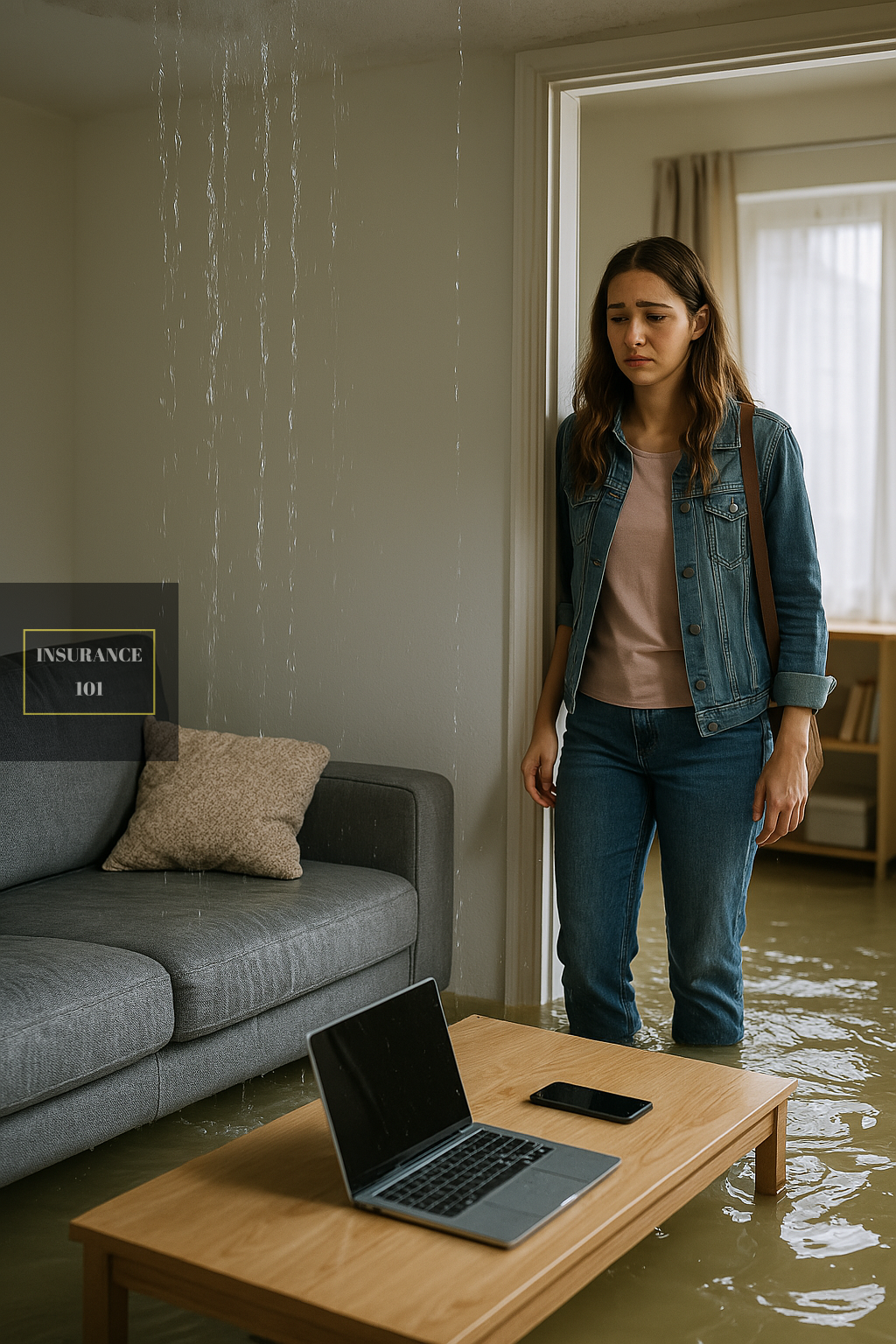When the Unexpected Happens: Are You Protected?
In December 2024, Sarah, a young graphic designer living in San Francisco, returned home to find her apartment flooded after the tenant above her left the bathtub running. Her brand-new MacBook Pro, camera gear, and vintage record collection were all destroyed. Worse still, her landlord’s insurance didn’t cover a single cent of her personal losses.
Sarah had skipped renters insurance thinking, “I’m just renting—why would I need it?” She isn’t alone.
According to a 2024 report by the Insurance Information Institute, over 56% of renters in the United States do not carry renters insurance—despite the relatively low cost and substantial benefits it offers.
In this comprehensive article, we’ll demystify renters insurance, explore what it covers (and what it doesn’t), calculate its actual value, and share compelling examples that could save you thousands of dollars. Whether you’re in New York, Nairobi, or New Delhi, this coverage is more relevant than ever in our increasingly volatile world.
What Is Renters Insurance?
Renters insurance, also known as tenant insurance, is a policy designed to protect individuals who rent apartments, houses, or other residential spaces. While your landlord’s insurance policy covers the structure of the building, it typically does not cover your personal belongings—or protect you if someone gets injured in your rented space.
Key Components of Renters Insurance
Here’s what most standard renters insurance policies include:
1. Personal Property Coverage
Covers your personal belongings (furniture, electronics, clothing) if they’re stolen, damaged, or destroyed by covered events like fire, theft, or burst pipes.
Example: If your apartment is burglarized and your laptop and TV are stolen, renters insurance can reimburse you for their current value or the cost to replace them.
2. Liability Protection
Covers legal fees and medical costs if someone is injured in your home or you accidentally cause damage to someone else’s property.
Real-life scenario: In 2023, a tenant in Boston was sued after her dog bit a guest. Her renters insurance covered $17,000 in legal and medical costs.
3. Additional Living Expenses (ALE)
If a fire or covered disaster makes your home temporarily uninhabitable, ALE covers hotel stays, meals, and other costs.
4. Medical Payments to Others
Even minor injuries like slips or cuts in your apartment could cost you. This clause helps pay medical bills regardless of fault.
The Real Cost: Is Renters Insurance Expensive?
Not at all.
2024 Global Average Premiums for Renters Insurance (Annual):
| Country | Average Annual Premium | Coverage Limit |
|---|---|---|
| United States | $179 | $20,000 |
| United Kingdom | £130 | £25,000 |
| Australia | AUD 220 | AUD 30,000 |
| Kenya | KES 4,500 | KES 500,000 |
| India | ₹1,200 | ₹1,000,000 |
(Source: OECD, World Bank, Insurance Regulatory Bodies, 2024)
You can often pay as little as $10–$15/month for coverage that could save you tens of thousands of dollars.
Formula: Calculating the Value of Renters Insurance
To assess if renters insurance is “worth it,” use the following basic risk-benefit ratio formula:
Risk-Benefit Ratio = (Expected Loss × Probability) / Annual Premium
Let’s take an example:
- Value of belongings: $25,000
- Probability of burglary or damage in urban area (average): 3%
- Premium: $180/year
Risk-Benefit = ($25,000 × 0.03) / 180 = $750 / 180 ≈ 4.17
A ratio above 1 means your expected loss outweighs the premium, making the policy financially wise.
Why Renters Often Skip Insurance (And Why That’s Risky)
Myth 1: “My landlord’s insurance covers me.”
Wrong. Your landlord’s policy only covers the building, not your personal items.
Myth 2: “I don’t own anything valuable.”
Try adding up the cost of your phone, laptop, clothes, shoes, books, kitchenware, and furniture. Most renters own at least $15,000–$25,000 worth of items.
Myth 3: “I’ll just save money for emergencies.”
A fire or theft could wipe out your belongings overnight. Without insurance, replacing everything from scratch could derail your finances.
Global Trend: Rising Renters and Shrinking Protection
The United Nations Human Settlements Programme (UN-Habitat) projects that over 70% of the global population will live in urban areas by 2050. More renters mean higher exposure to risks like theft, fire, flooding, and liability.
Yet, according to Allianz Global Insurance Report 2024, renters insurance remains underutilized in:
- Africa (Only 12% penetration)
- South Asia (Below 8%)
- Latin America (Approx. 14%)
This highlights an urgent need for awareness.
Expert Perspective: Interview with an Industry Veteran
I had the privilege of speaking with Daniel Mwangi, Head of Underwriting at AAR Insurance Kenya, who shared:
“We see many young professionals renting apartments with expensive electronics, yet they overlook renters insurance. The irony is, many of them insure their phones but not the home items worth five times more. Renters insurance isn’t a luxury—it’s a financial safety net.”
Real Stories, Real Savings
Case Study: Munich Apartment Fire, 2023
In 2023, a cooking fire in a rented apartment in Munich destroyed personal belongings of five tenants. One tenant, insured under AXA’s renters plan, received over €18,000 in reimbursement. The others received nothing and had to replace items out-of-pocket.
What Does Renters Insurance NOT Cover?
Not every loss is covered. Common exclusions include:
- Floods (you need separate flood insurance)
- Earthquakes (covered under a rider)
- Pest damage (e.g., termite destruction)
- Intentional acts of damage
Always read your policy exclusions carefully or ask your insurer.
Choosing the Right Policy: What to Look For
1. Replacement Cost vs. Actual Cash Value
- Actual Cash Value (ACV): Pays depreciated value
- Replacement Cost: Pays what it costs to buy a new one
Tip: Always opt for replacement cost coverage if you can afford it.
2. Coverage Limits
Make sure your policy matches the value of your belongings. Underinsuring could leave you exposed.
3. Deductibles
The amount you must pay before your insurance kicks in. A higher deductible means lower premiums, but more out-of-pocket risk.
4. Add-Ons (Endorsements)
These include:
- Valuables coverage for jewelry, art, or high-end electronics
- Identity theft protection
- Pet liability coverage
How to Get Renters Insurance (Step-by-Step)
- Inventory Your Belongings using a spreadsheet or app like Sortly
- Get Quotes Online via comparison platforms like Policygenius or local insurers
- Choose Coverage Type (ACV or Replacement)
- Select Limits and Add-Ons
- Buy and Store Documents Digitally
Renters Insurance vs. Homeowners Insurance: Key Differences
| Feature | Renters Insurance | Homeowners Insurance |
|---|---|---|
| Covers the Structure | No | Yes |
| Covers Personal Property | Yes | Yes |
| Liability Protection | Yes | Yes |
| Cost | Lower (avg. $15/month) | Higher (avg. $120/month) |
| Required by Mortgage? | No | Yes |
Is Renters Insurance Mandatory?
It depends. Some landlords and property managers require renters insurance as a lease condition, especially in North America and Europe. Even when optional, it’s highly recommended for all renters.
Future-Proofing Your Finances
With rising inflation, increased digital asset ownership, and worsening climate events, renters insurance is more relevant than ever. In 2024 alone, insured rental claims rose by 18%, according to Swiss Re.
Expect more insurers to bundle renters insurance with cyber protection, green coverage, or even AI-driven claims settlement by 2026.
Final Words: Is Renters Insurance Worth It?
In a word—absolutely.
For the cost of a weekly coffee run, you gain peace of mind, financial protection, and legal coverage. Whether you’re a student in Canada, a working professional in Kenya, or a family in Australia, renters insurance isn’t just for “what ifs”—it’s for the when it happens.
Glossary of Terms
- Actual Cash Value (ACV): The value of an item after depreciation.
- Additional Living Expenses (ALE): Costs covered if your home becomes uninhabitable.
- Coverage Limit: The maximum amount an insurer will pay.
- Deductible: The amount paid out of pocket before insurance kicks in.
- Endorsement: Optional coverage added to a base policy.
- Liability Protection: Covers injury or property damage you cause to others.
- Personal Property: Your belongings, like electronics, clothes, furniture.
- Replacement Cost: The cost to replace an item with a new one.
- Tenant Insurance: Another name for renters insurance.
Discover more from INSURANCE 101
Subscribe to get the latest posts sent to your email.




One thought on “Renters Insurance: Why It’s Worth It”